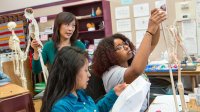An Inquiry-Led Science Classroom
Teachers can guide students to be in control of their learning by asking questions that promote reflection and engaging class discussions.
Your content has been saved!
Go to My Saved Content.Teachers agree that student questions are important during classroom discussions. Yet in practice, students ask remarkably few questions, and even fewer in search of knowledge. In particular, the three-part exchange structure known as triadic dialogue is widely used in middle and high school science classrooms.
Triadic dialogue consists of three stages: initiation, response, and evaluation, commonly referred to as the IRE model. Typically, the teacher asks a knowledge-based question that requires a predetermined short answer at the recall or lower-order cognitive level. Students respond to the question. Responses are evaluated, whereby correct answers are praised and wrong answers are corrected.
Modify the IRE Model to Encourage Dialogue and Reflection
While the IRE model might appear to restrict students’ thinking, it has its merits in the classroom, usually in the form of a process called revoicing. By revoicing and paraphrasing the students’ correct answers in the evaluation stage, teachers affirm the students’ responses, make their ideas available to the class, and assist them in verbalizing their thoughts as they co-construct a response. Through revoicing, teachers can scaffold students’ answers by encouraging further dialogue and questioning to support their construction of meaning and to reciprocally build on their contributions.
One modification to the IRE model is the “reflective toss,” where the teacher throws the responsibility for thinking back to the whole class by asking a question in response to a student’s answer, thereby shifting the classroom discussion toward more reflective discourse. These questions are usually open-ended and require one- or two-sentence answers. The teacher engages students in higher-order thinking to appraise and extend students’ ideas and encourage deeper thinking. While the dialogic discourse allows students to argue and justify their ideas, the triadic dialogue aids in emphasizing the constructed shared knowledge.
Alternating between these two types of discourse is ideal for developing conceptual thinking. Flexibility in questioning allows teachers to adjust the questions to accommodate their students’ contributions and to respond to their thinking in a neutral rather than evaluative manner.
The subsequent questions that we ask challenge students and encourage them to elaborate on their ideas by hypothesizing, predicting outcomes, generating explanations, inferring, concluding, and self-evaluating their thinking. Essentially, by redirecting the evaluation stage of the IRE model back to the whole class, teachers establish a classroom environment that values discussion, justification, exploration, and the co-construction of knowledge. This approach shifts authority for evaluating answers from the teacher to the entire class so that students can make an effort to understand what their peers are saying.
Welcome All Student Questions
Several factors may affect the frequency and quality of questions that your students ask—such as the grade level, their prior knowledge, the nature of the topic, your attitude, your teaching style, and the overall classroom environment. Students might initially ask closed-ended, knowledge-based questions because they’re easier to formulate compared with questions that involve analysis or extension of ideas. These questions are usually not investigable and can be answered with yes or no. Additionally, if the classroom environment is unwelcoming and if students are fearful that they might be bullied or labeled as the “student who doesn’t understand,” they will tend to raise questions in their minds but rarely out loud in the classroom.
Closed-ended, knowledge-based student questions:
- Does volume increase when water freezes?
- Does a glass bottle crack in low temperatures?
- Why does a mealworm become a beetle?
By welcoming all questions, you increase the probability that “better” questions will eventually be asked. Each question your students ask has the potential to address the conceptual goals of the lesson. Even the seemingly lower-level questions can serve as means to formulate more sophisticated questions. You can guide students to shift from asking typical questions to questions that have the potential to focus their learning on explanation instead of recalling facts.
These guiding questions are referred to as wonderment questions. Wonderment questions stimulate students to generate explanations, propose solutions, hypothesize, predict, and enrich the classroom discussion—leading to a cascade of knowledge construction. This isn’t to say that comprehension-level questions are less important. On the contrary, knowledge-based questions are imperative to review learning, identify misconceptions, and facilitate the connection of preexisting concepts with new ones.
Teacher-guided wonderment questions:
- Why did the bottle break?
- Why does the bottle break when it freezes?
- Do all worms become beetles?
- When do mealworms look like beetles?
The questions you ask can serve as models for the students. It’s important for us as teachers to demonstrate to students that their questions are valued, model asking investigable or exploratory questions by providing examples, and provide explicit practice in refining questions.
The questions that we ask can do the following:
- Guide students’ participation in class discussions
- Increase students’ interest
- Identify misconceptions
- Stimulate students’ prior knowledge
- Allow students to develop an opinion about a topic
In inquiry-based learning, questions include the problem context, are testable, and begin with “What,” “How,” or “Why”: “How is…?” “How did … happen?” “What does … mean?” “What can you say about…?” “What would happen if…?” “How would you test…?” “Can you predict the outcome if…?”
In inquiry-based learning, problem-finding (questioning) is equally important to problem-solving. Encourage students to seek knowledge so that their questions become a critical part of their self-directed learning process. We want classrooms where teachers elicit and use student questions effectively in instruction to extend their thinking and reasoning.
Discussing science is more than using scientific terminology and answering questions. Formulating a question is a cognitive skill that lies at the heart of inquiry-based learning. Questions posed at critical junctures of a lesson can focus our students’ attention on the main aspects of the concept and create the space for inquiry and learning.
